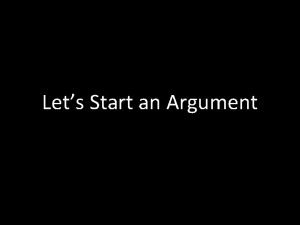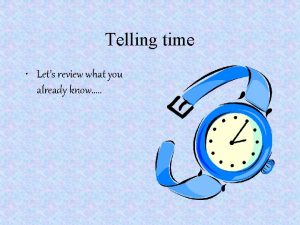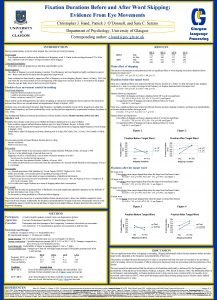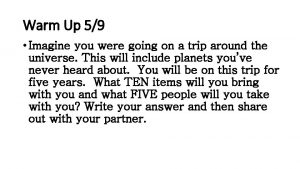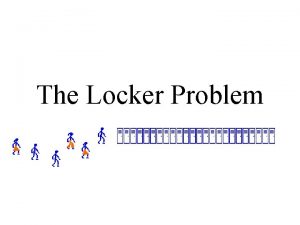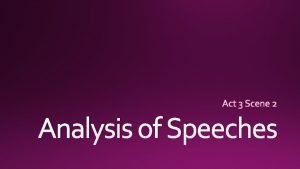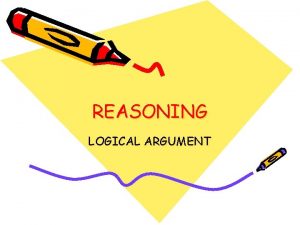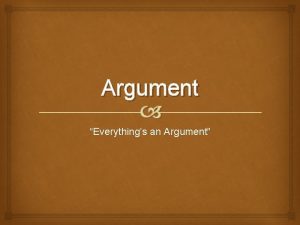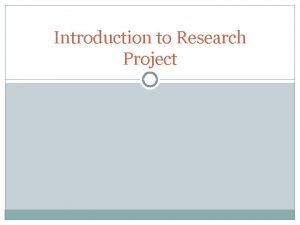Lets Start an Argument What do you imagine



























- Slides: 27

Let’s Start an Argument

What do you imagine? Share with me!

Fighting , Heated Yelling, Attacking Accusative/ Blaming/ Defensive behavior Miscommunication / hurt, closed off, lack of understanding

OK! Let’s Rephrase that.

Let’s Start an “Academic” Argument!

: We need to understand the purpose. Persuading others for: -Truth -Knowledge / Facts -Problem solving -Humanism (Belief of making life better)


One professor simply said, “An Essay is… Say what you are going to say! Say it! Say what you said!”

Logic I often tell my students that they need to have at least 3 Reasons The bare minimum for something to stand on its own.

And a counter argument To get away from the 5 paragraph Structure

Argument is An ancient Art with many techniques

The Classical View Marcus Tullius Cicero c. 80 B. C. E • Exordium --Setting of tone and topic to exhort (strongly encourage) listening • Narratio—-Narration of the facts and data around the topic • Partitio– (Thesis)- explaining the result and manner to be argued • Confirmatio—(Body) Evidence and proofs supporting your claim • Refutatio—(counter Argument-Body) Take on the opponents argument and refute it. • Peroratio—(Conclusion): Restate points and guide the reader to future.

Let’s look at the essay in front of us! 1. Take a few minutes to read the essay. 2. Can you identify the Classical Elements of argument? • Exordium- • Narratio— • Partitio– • Confirmatio— • Refutatio— • Peroratio—

Complexity

Toulmin Model 1. Claim: Partitio 2. Data 1: Narratio 3. Warrant 1: Cofirmatio 4. Data 2: Narratio 5. Warrant 2: Cofirmatio 6. Data 3: Narratio 7. Warrant 3: Cofirmatio 8. Counterclaim: Refutatio 9. Rebuttal: Refutatio 10. Conclusion: Peroratio

Outline 1. Introduction/Thesis-claim 2. Body Paragraph 1: 1 st point and evidence. 3. Body Paragraph 2: 2 nd point and evidence 4. Body Paragraph 3: Refute your opposition's first point. 5. Body Paragraph 4: Refute your opposition's second point. 6. Conclusion/ Restate Thesis

Outline II 1. Introduction/ Thesis-Claim 2. Body Paragraph 1: Refute your opposition's first point. 3. Body Paragraph 2: Refute your opposition's second point. 4. Body Paragraph 3: Present your first point and supporting evidence. 5. Body Paragraph 4: Present your second point and supporting evidence. 6. Conclusion/ Restate Thesis

Freedom ut, both the topic and the audience set the boundaries of your freedom.

An Academic Argument is an act of benevolence. .

So,

Stay Calm!

Present your reasons and evidence to support your thesis! and

Acknowledge Your audience (those who disagree with you) In your essay

Help them reach the conclusion with you!

If you need another example, Here is…

A psychologist’s view: A very gentle approach

Rogerian Argument Six parts (not paragraphs) I. Intro- Present the topic as a problem not as an issue II. Make Fair Statements of the Opposing Position III. Statement of Contexts in Which That Opposition May Be Valid. IV. Fair Statement of Your Own Position. V. Statement of Contexts in Which Your Position Is Valid. VI. Statement of How Readers Would Benefit by Adopting at Least Elements of Your Position
 Story behind this picture
Story behind this picture If you can imagine it you can achieve it
If you can imagine it you can achieve it Ontological vs teleological
Ontological vs teleological Can you argue
Can you argue Site:slidetodoc.com
Site:slidetodoc.com Jump start triage algorithm
Jump start triage algorithm I already know in spanish
I already know in spanish The water lets you in
The water lets you in Lets see what you already know
Lets see what you already know Lets see what you already know
Lets see what you already know Lets see what you know
Lets see what you know The word-skipping technique lets you figure out
The word-skipping technique lets you figure out Imagine this if you had $86 400
Imagine this if you had $86 400 Imagine you are hungry
Imagine you are hungry Hot face
Hot face Imagine you are holding an apple
Imagine you are holding an apple Imagine you are a doctor
Imagine you are a doctor Engineering design process song
Engineering design process song Can you imagine how i felt
Can you imagine how i felt Imagine you are studying english
Imagine you are studying english Imagine you are stranded on a desert island essay
Imagine you are stranded on a desert island essay Life without colors
Life without colors Imagine that you have a bag containing 10 marbles
Imagine that you have a bag containing 10 marbles Imagine you are going
Imagine you are going The locker problem
The locker problem Imagine that you are preparing a project with your friend
Imagine that you are preparing a project with your friend Close your eyes imagine that you are the protagonist
Close your eyes imagine that you are the protagonist Imagine you are going
Imagine you are going



